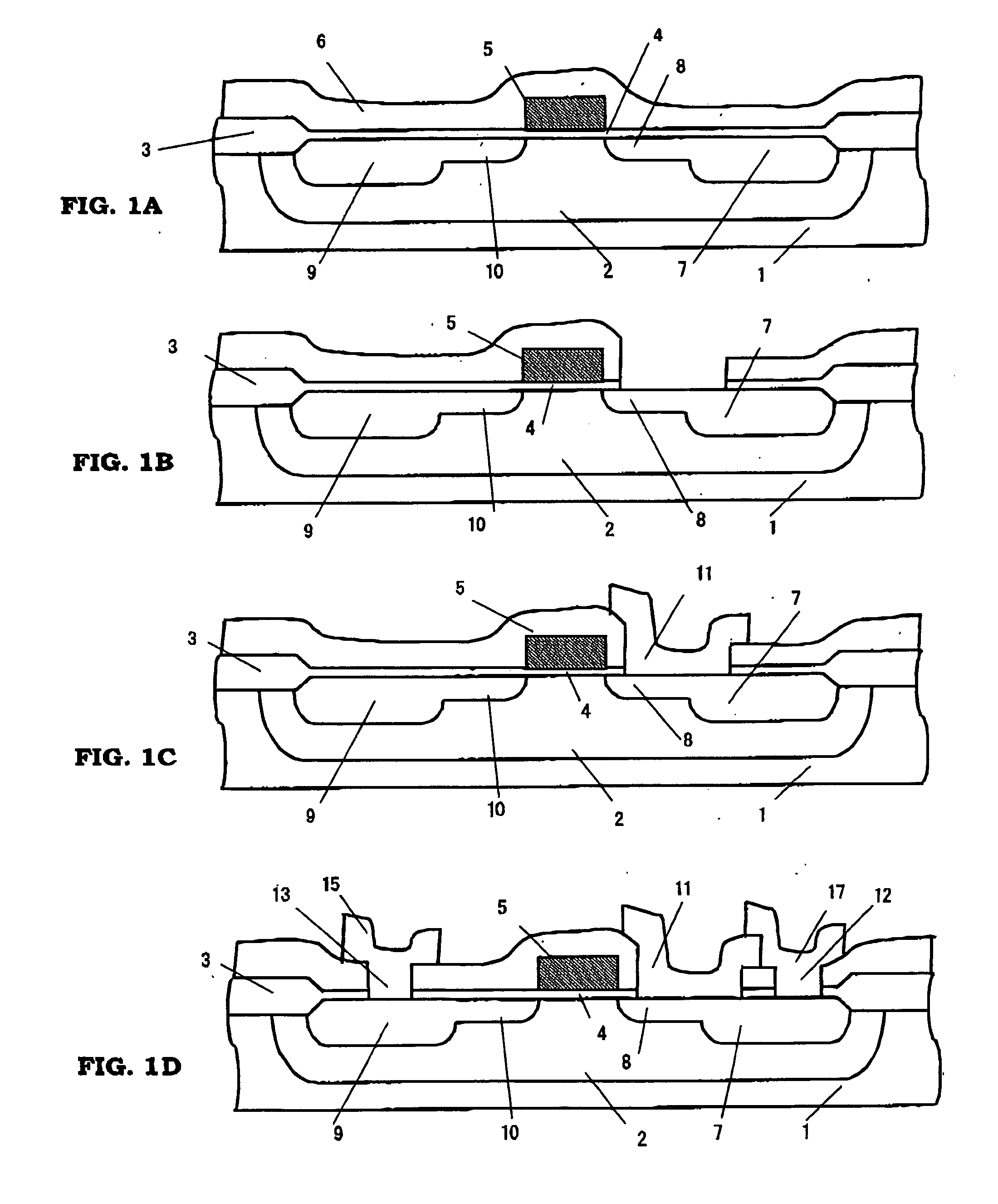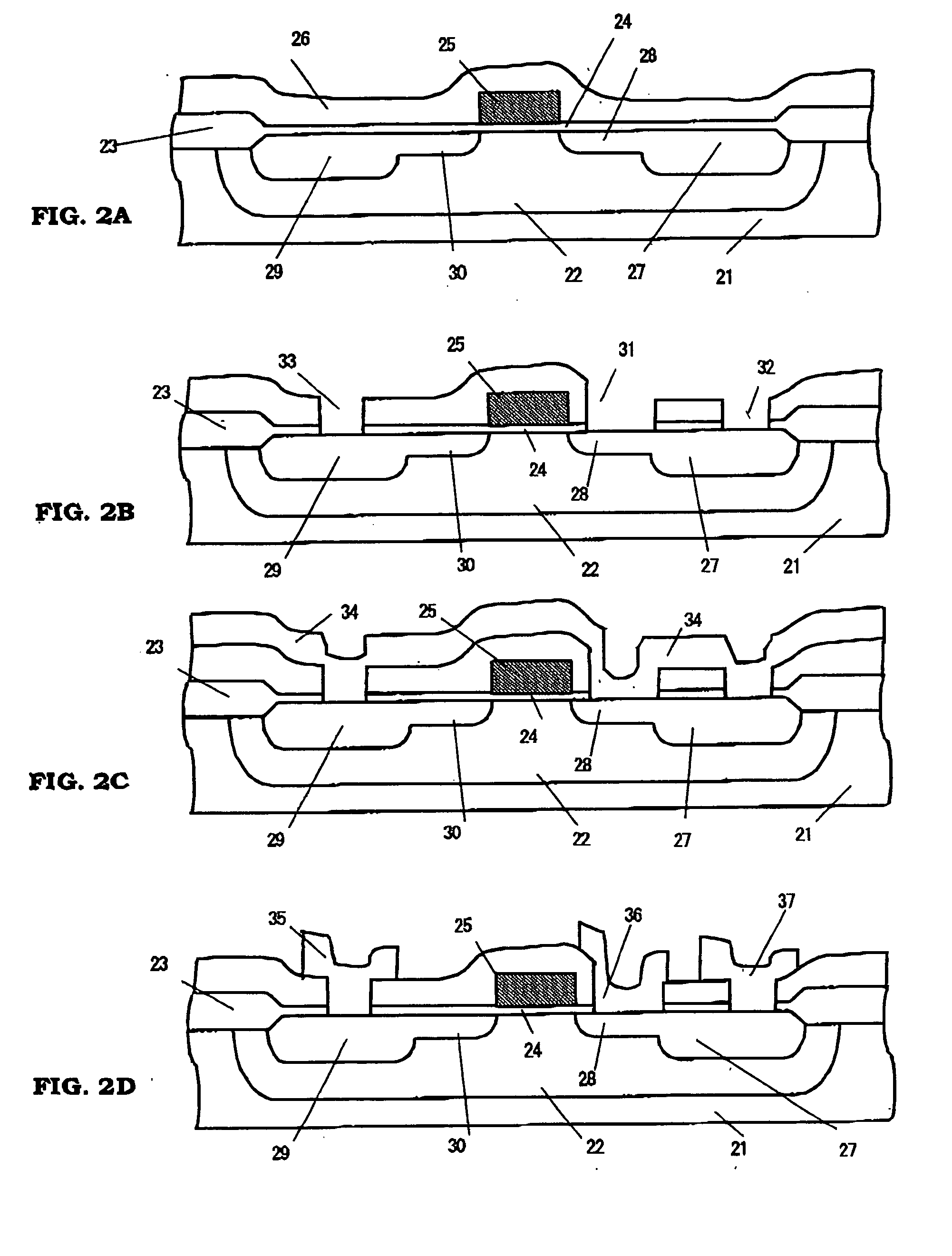Semiconductor integrated circuit device and a manufacturing method for the same
a technology of integrated circuit device and manufacturing method, which is applied in the direction of semiconductor devices, basic electric elements, electrical equipment, etc., can solve the problems of reducing the esd immunity, the esd immunity falls below the standard, and the element is destroyed, so as to improve the esd immunity and the element's destruction resistance, reduce the drain resistance, and prevent the effect of thermal destruction of silicon
- Summary
- Abstract
- Description
- Claims
- Application Information
AI Technical Summary
Benefits of technology
Problems solved by technology
Method used
Image
Examples
first embodiment
[0092]FIGS. 1A to 1D are schematic cross-sectional diagrams showing sequential process steps according to a manufacturing method for a semiconductor device of the present invention.
[0093] In FIG. 1A, a P-type semiconductor substrate 1, for example, doped with boron at an impurity concentration to attain a resistivity of 20 Ωcm to 30 Ωcm, is subjected to, for example, ion implantation of boron at a dose of 1×1011 atoms / cm2 to 1×1013 atoms / cm2 and to annealing at 1,000 to 1,200° C. for several hours to ten-odd hours, to form a diffusion layer or a P-type well 2. Here, an explanation is given to process steps for forming a P-type well on a P-type semiconductor substrate, while a P-type well may also be formed on an N-type semiconductor substrate in a similar manner. The substrate can have either conductivity type, which is irrelevant to the gist of the present invention.
[0094] Then, a field insulating film 3, for example, a thermal oxide film with a thickness of several thousands Å to...
second embodiment
[0101]FIGS. 2A to 2D are schematic cross-sectional diagrams showing sequential process steps according to a manufacturing method for a semiconductor device of the present invention.
[0102] In FIG. 2A, a P-type semiconductor substrate 21, for example, doped with boron at an impurity concentration to attain a resistivity of 20 Ωcm to 30 Ωm, is subjected to, for example, ion implantation of boron at a dose of 1×1011 atoms / cm2 to 1×1013 atoms / cm2 and to annealing at 1,000 to 1,200° C. for several hours to ten-odd hours, to form a diffusion layer or a F-type well 22. Here, an explanation is given on process steps for forming a P-type well on a P-type semiconductor substrate, while a F-type well may also be formed on an N-type semiconductor substrate in a similar manner. The substrate can have either conductivity type, which is irrelevant to the gist of the present invention.
[0103] Then, a field insulating film 23, for example, a thermal oxide film with a thickness of several thousands Å ...
third embodiment
[0109]FIGS. 3A to 3D are schematic cross-sectional diagrams showing sequential process steps according to a manufacturing method for a semiconductor device of the present invention.
[0110] As shown in FIG. 3A, a P-type semiconductor substrate 41, for example, doped with boron at an impurity concentration to attain a resistivity of 20 Ωcm to 30 Ωcm, is subjected to, for example, ion implantation of boron at a dose of 1×1011 atoms / cm2 to 1×1013 atoms / cm2 and to annealing at 1,000 to 1,200° C. for several hours to ten-odd hours, to form a diffusion layer or a P-type well 42. Here, an explanation is given on process steps for forming a P-type well on a P-type semiconductor substrate, while a P-type well may also be formed on an N-type semiconductor substrate in a similar manner. The substrate can have either conductivity type, which is irrelevant to the gist of the present invention.
[0111] Then, a field insulating film 43, for example, a thermal oxide film with a thickness of several th...
PUM
 Login to View More
Login to View More Abstract
Description
Claims
Application Information
 Login to View More
Login to View More - R&D
- Intellectual Property
- Life Sciences
- Materials
- Tech Scout
- Unparalleled Data Quality
- Higher Quality Content
- 60% Fewer Hallucinations
Browse by: Latest US Patents, China's latest patents, Technical Efficacy Thesaurus, Application Domain, Technology Topic, Popular Technical Reports.
© 2025 PatSnap. All rights reserved.Legal|Privacy policy|Modern Slavery Act Transparency Statement|Sitemap|About US| Contact US: help@patsnap.com



